Damn the torpedos, full speed ahead”
–Admiral David Farragut
Stu surprised me with a trip to Alabama, a place where he lived for many years. I’d never visited Alabama and am now a big fan!
The quote above is something we heard a lot growing up and in war movies, but do you know where that phrase originated?
Union Admiral David Farragut was leading ships into Mobile Bay in Alabama in an effort to capture Fort Morgan during the Civil War when he yelled to his naval comrades, “Damn the torpedos, full speed ahead!” The Battle of Mobile Bay began on August 5, 1864 and lasted two-weeks. The battle ended with the Fort’s surrender to Union troops on August 23, 1864.
The construction of Fort Morgan, we learned, was begun in 1819 and completed in 1834. Prior to 1819, the Fort was called Fort Bowyer which was built in 1813 to guard against British attack. The British, in fact, attacked that Fort twice during the War of 1812. The first of those battles was won by the Americans but the fort was captured by the British in the second attack. Fort Bowyer was returned to the U.S. as a condition of surrender after the War of 1812.
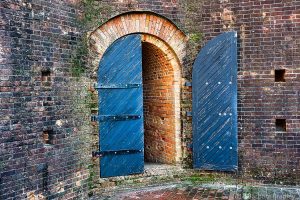
Fort Morgan is shaped like a star or pentagon and was originally all brick, built by slaves. Fort Morgan is one of the 42 coastal forts built to prevent any enemy from approaching the U.S. by sea. (see our blog post on Fort Pickens in Florida at: https://tinyurl.com/y2h9mjo8) The star shape also allowed for defense of Mobile Point by enemies on land.
The Fort saw four wars-the Civil War, the Spanish-American War and World War I and World War II.
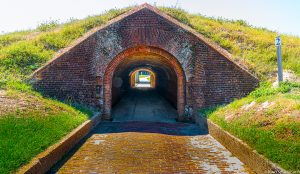
We wandered some of the 479 acres at the site. We explored artillery batteries built between 1895 and 1904 and other historic military buildings. There is a museum that has original letters, uniforms and personal items of the soldiers stationed at the Fort.
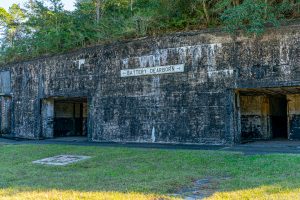
Beginning in 1895, the fort was further fortified. Fort Morgan became the largest permanent military base in Alabama. Over 100 structures were built to support America’s coastal defense here. During WWI, over 2,000 troops were stationed at Fort Morgan.*
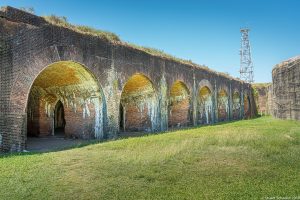
Stu and I explored what we called the ” tunnel rooms” at the Fort, trying to imagine what fighting was like for the thousands of soldiers stationed there since 1834.
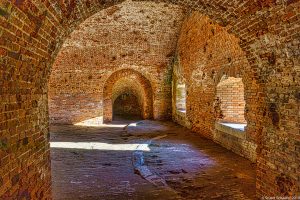
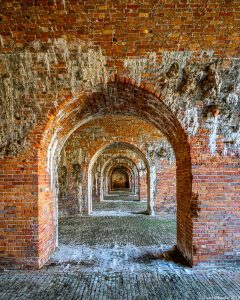
There’s more! There are picnic grounds, access to the beach and a ferry to and from Dauphin Island!
THE FERRY
If you ride the Mobile Bay Ferry you’ll enjoy some fantastic scenery and give your grandchildren a thrill! Dolphins can be seen following the ferry as it makes its way. Dauphin Island is well known to birders too.
The Ferry connects SR 193 at Dauphin Island on the west side of the Bay with SR180 at Mobile Point on the eastern side of the Bay. The trip is about 40 minutes long. From the ferry, you can see both Fort Gaines on Dauphin Island and Fort Morgan at Mobile Point. It is a scenic and historic ride. Don’t miss it!
FERRY INFORMATION:
See: https://www.mobilebayferry.com
Being from Kansas, it was a treat for me to see all the oil rigs in the gulf as we started home. You will have a great day at Fort Morgan!
DIRECTIONS TO Fort Morgan:
Fort Morgan is at the western end of Highway 180, 22 miles west of Highway 59 in Gulf Shores.
51 State Highway 180
Gulf Shores, Alabama 36542
251-540-5257
8 a.m.-5 p.m. daily
Fees:
Adults, $8
College Students, Seniors and Children, $5
Military are free